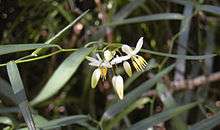Geitonoplesium
| Geitonoplesium cymosum | |
|---|---|
 | |
| Flowers, 26 Dec 2011 | |
 | |
| Fruit, Feb 2011 at Paruna Reserve, Como, Sydney, NSW, by John Tann | |
| Scientific classification | |
| Kingdom: | Plantae |
| Clade: | Angiosperms |
| Clade: | Monocots |
| Order: | Asparagales |
| Family: | Asphodelaceae |
| Subfamily: | Hemerocallidoideae |
| Genus: | Geitonoplesium A.Cunn. ex R.Br.[1] |
| Species: | G. cymosum |
| Binomial name | |
| Geitonoplesium cymosum (R.Br.) A.Cunn. ex R.Br.[2] | |
| Synonyms[3] | |
| |
Geitonoplesium is a genus of a sole species Geitonoplesium cymosum, the scrambling lily. It is a member of the family Asphodelaceae, subfamily Hemerocallidoideae.[4] They grow naturally as scrambling vines in rainforests, drier forests and woodlands, of eastern Australia, the Philippines, Indonesia, New Guinea, Fiji, New Caledonia, Norfolk Island and Lord Howe Island.[5][6]
The leaves are variable, usually narrow-lanceolate to linear, usually 2–10 cm (0.8–3.9 in) long and 3–25 mm (0.1–1.0 in) wide. Both surfaces of leaves are glossy, with the midvein prominent and raised on upper surface. The flowers are mauve to white. The globose berries are 1–2 cm (0.4–0.8 in) in diameter and contain numerous black seeds.[5][7] The high degree of variation in the shape of the leaves has resulted in the establishment of numerous infraspecific taxa over the years, none of which is recognised by most present-day systematists.[8]
Uses
The shoots are harvested and eaten like asparagus and have a pleasant beany-like flavor.[9] Uncommon in cultivation.
References
- ↑ "Geitonoplesium A.Cunn. ex R.Br.". Australian Plant Name Index (APNI), IBIS database. Centre for Plant Biodiversity Research, Australian Government. Retrieved 23 June 2013.
- ↑ "Geitonoplesium cymosum (R.Br.) A.Cunn. ex R.Br.". Australian Plant Name Index (APNI), IBIS database. Centre for Plant Biodiversity Research, Australian Government. Retrieved 23 June 2013.
- ↑ "Geitonoplesium cymosum (R.Br.) A.Cunn. ex R.Br.". World Checklist of Selected Plant Families (WCSP). Royal Botanic Gardens, Kew. Retrieved 5 Mar 2016 – via The Plant List.
- ↑ Stevens, P.F. (2001 onwards). "Hemerocallidoideae". Angiosperm Phylogeny Website. Retrieved 2016-06-10.
- 1 2 Hyland, B. P. M.; Whiffin, T.; Zich, F. A.; et al. (Dec 2010). "Factsheet – Geitonoplesium cymosum". Australian Tropical Rainforest Plants. Edition 6.1, online version [RFK 6.1]. Cairns, Australia: Commonwealth Scientific and Industrial Research Organisation (CSIRO), through its Division of Plant Industry; the Centre for Australian National Biodiversity Research; the Australian Tropical Herbarium, James Cook University. Retrieved 23 June 2013.
- ↑ Conran, John G.; Clifford, H. T. (1986). "Geitonoplesium (Smilacaceae)". Flora of Australia: Volume 46: Iridaceae to Dioscoreaceae (online version, by P. S. Green). Flora of Australia series. CSIRO Publishing / Australian Biological Resources Study. p. 194. ISBN 978-0-644-04356-4. Retrieved 18 June 2013.
- ↑ Harden, Gwen J. (July 2001). "Geitonoplesium cymosum (R.Br.) A.Cunn. ex Hook. – New South Wales Flora Online". PlantNET – The Plant Information Network System. 2.0. Sydney, Australia: The Royal Botanic Gardens and Domain Trust. Retrieved 18 June 2013.
- ↑ Laferrière, Joseph E. (1995). "Nomenclature and type specimens in Eustrephus R.Br. and Geitonoplesium Hook. (Geitonoplesiaceae)". Austrobaileya. 4 (3): 391–399. Retrieved 11 Dec 2013.
- ↑ Low, Tim (1991). Wild food plants of Australia (revised ed.). North Ryde, N.S.W.: Angus & Robertson. p. 122. ISBN 9780207169304.
| Wikimedia Commons has media related to Geitonoplesium cymosum. |